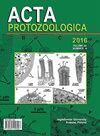Antifreeze Water-Rich Dormant Cysts of the Terrestrial Ciliate Colpoda cucullus Nag-1 at −65 ℃: Possible Involvement of Ultra-Antifreeze Polysaccharides
IF 1.2
4区 生物学
Q4 MICROBIOLOGY
引用次数: 2
Abstract
We found that the water-rich (osmolality below 0.052 Osm/l) wet resting cysts of the soil ciliate Colpoda cucullus Nag-1 were tolerant to extremely low temperature (−65℃). When cell fluid obtained from the resting cysts was cooled at −65℃, small particles of ice crystals did not grow into large ice crystals. At −65℃, the cysts shrank due to an outflow of water, because a vapor pressure difference was produced between the cell interior and freezing surrounding medium. The osmolality of these shrunk cells was estimated 0.55 Osm/l, and the freezing point depression of the shrunk cell fluid was estimated to be 1.02℃. Hence, the antifreeze ability of wet cysts at −65℃can not be explained by freezing point depression due to elevation of cytoplasmic osmolality. The cytoplasm of resting cysts was vividly stained red with periodic acid-Schiff (PAS) and stained purple with toluidine blue. On the other hand, the excystment-induced cysts were not stained with PAS, and exhibited a loss of the antifreeze activity. PAS staining of SDSPAGE gel obtained from encysting Colpoda cells showed that a large amount of PAS-positive macromolecules accumulated as the encystment stage progressed. These results suggest that antifreeze polysaccharides may be involved in the antifreeze activity of C. cucullus Nag-1 dormant forms.- 65℃条件下陆生纤毛虫Colpoda cucullus Nag-1富防冻水休眠囊:超防冻多糖可能参与
研究发现,土壤纤毛虫毛囊(Colpoda cucullus Nag-1)富含水分(渗透压低于0.052 Osm/l)的湿息囊对极低温(- 65℃)具有良好的耐受性。当从静止的囊肿中获得的细胞液在- 65℃下冷却时,小的冰晶颗粒不会生长成大的冰晶。在−65℃时,由于细胞内部和周围的冷冻介质之间产生了蒸汽压差,因此,由于水的流出,囊肿收缩。收缩细胞的渗透压估计为0.55 Osm/l,收缩细胞液的凝固点下降估计为1.02℃。因此,湿囊在- 65℃时的抗冻能力不能用细胞质渗透压升高引起的冰点降低来解释。静息期囊胞质经周期性酸希夫染色显红色,甲苯胺蓝染色显紫色。另一方面,系统诱导的囊肿未被PAS染色,并且表现出抗冻活性的丧失。囊泡阴道细胞的SDSPAGE凝胶PAS染色显示,随着囊泡期的进展,大量PAS阳性大分子积累。这些结果表明,抗冻多糖可能参与了黄瓜Nag-1休眠形式的抗冻活性。
本文章由计算机程序翻译,如有差异,请以英文原文为准。
求助全文
约1分钟内获得全文
求助全文
来源期刊

Acta Protozoologica
生物-微生物学
CiteScore
2.00
自引率
0.00%
发文量
8
审稿时长
>12 weeks
期刊介绍:
Acta Protozoologica - International Journal on Protistology - is a quarterly journal that publishes current and comprehensive, experimental, and theoretical contributions across the breadth of protistology, and cell biology of Eukaryote microorganisms including: behaviour, biochemistry and molecular biology, development, ecology, genetics, parasitology, physiology, photobiology, systematics and phylogeny, and ultrastructure. It publishes original research reports, critical reviews of current research written by invited experts in the field, short communications, book reviews, and letters to the Editor.
 求助内容:
求助内容: 应助结果提醒方式:
应助结果提醒方式:


